Change Management Strategies: Impact of BYOD, Culture, Restructuring
VerifiedAdded on 2022/10/19
|6
|1224
|401
Essay
AI Summary
This essay explores the critical area of organizational change, focusing on the introduction of Bring Your Own Device (BYOD) policies, cultural transformations, and organizational restructuring. It discusses the potential benefits, such as increased employee skills, creativity, and productivity, as well as the possible negative impacts, like data loss or employee resistance. The essay highlights the importance of leadership in managing change, citing examples like British Airways' successful restructuring. It also addresses relevant employment laws, particularly in Canada, which regulate organizational changes, emphasizing the need for legitimate reasons for termination, non-discrimination, and flexible work arrangements. Furthermore, the essay identifies the driving forces behind organizational changes, including technological advancements, market dynamics, and internal factors. Finally, it emphasizes the crucial role of human resource practitioners in communicating change and ensuring its successful implementation through careful planning and consideration of the impact on employees.
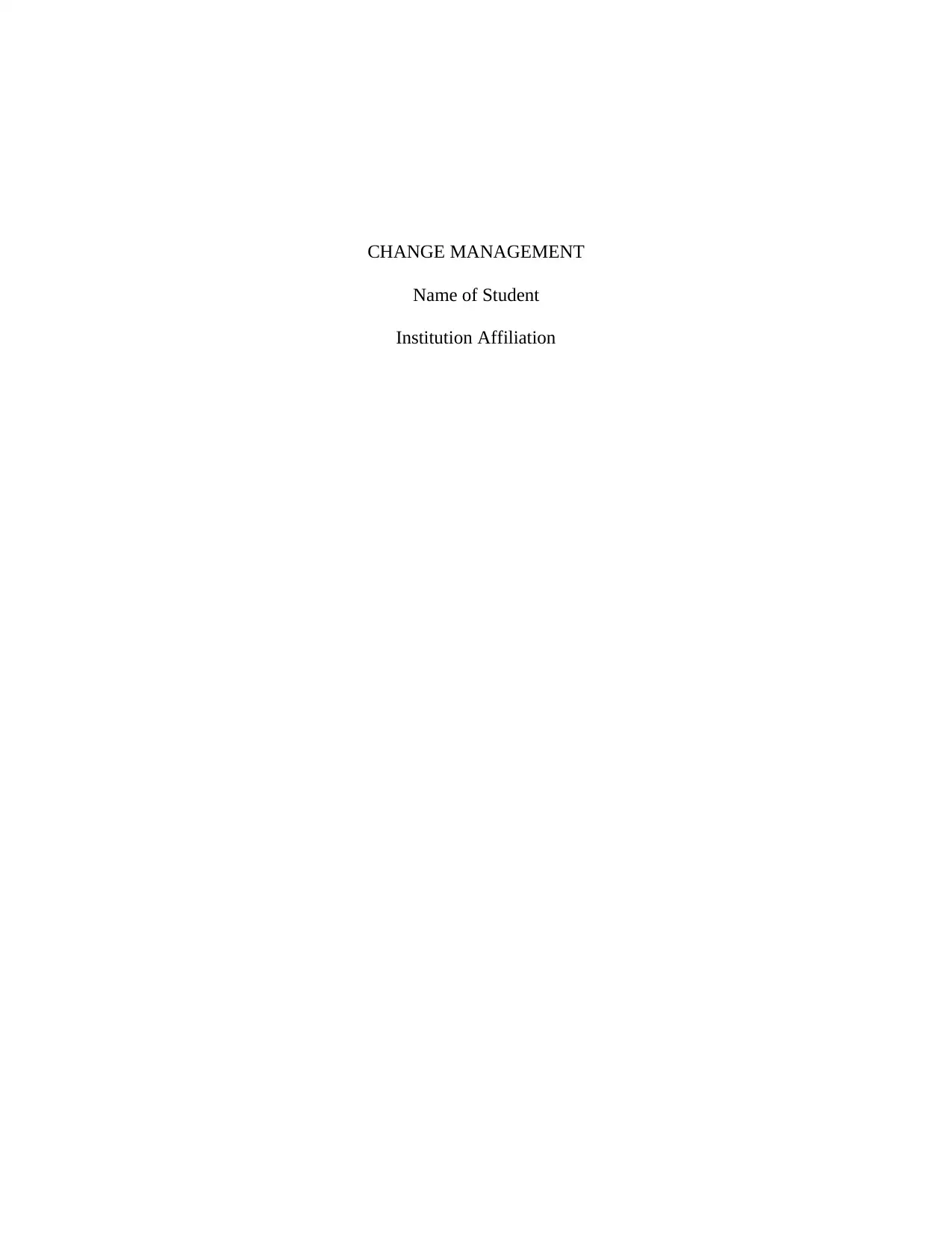
CHANGE MANAGEMENT
Name of Student
Institution Affiliation
Name of Student
Institution Affiliation
Paraphrase This Document
Need a fresh take? Get an instant paraphrase of this document with our AI Paraphraser
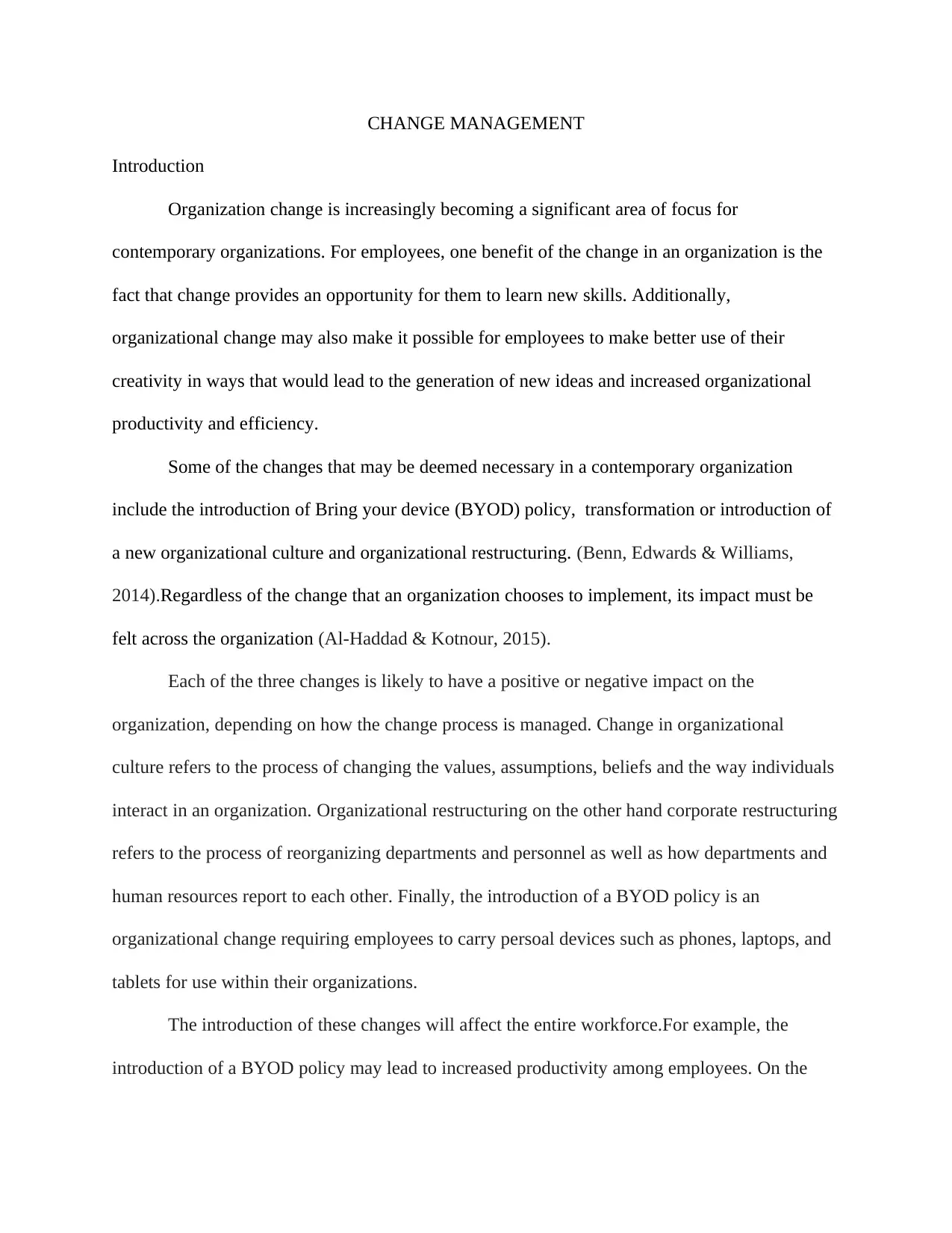
CHANGE MANAGEMENT
Introduction
Organization change is increasingly becoming a significant area of focus for
contemporary organizations. For employees, one benefit of the change in an organization is the
fact that change provides an opportunity for them to learn new skills. Additionally,
organizational change may also make it possible for employees to make better use of their
creativity in ways that would lead to the generation of new ideas and increased organizational
productivity and efficiency.
Some of the changes that may be deemed necessary in a contemporary organization
include the introduction of Bring your device (BYOD) policy, transformation or introduction of
a new organizational culture and organizational restructuring. (Benn, Edwards & Williams,
2014).Regardless of the change that an organization chooses to implement, its impact must be
felt across the organization (Al-Haddad & Kotnour, 2015).
Each of the three changes is likely to have a positive or negative impact on the
organization, depending on how the change process is managed. Change in organizational
culture refers to the process of changing the values, assumptions, beliefs and the way individuals
interact in an organization. Organizational restructuring on the other hand corporate restructuring
refers to the process of reorganizing departments and personnel as well as how departments and
human resources report to each other. Finally, the introduction of a BYOD policy is an
organizational change requiring employees to carry persoal devices such as phones, laptops, and
tablets for use within their organizations.
The introduction of these changes will affect the entire workforce.For example, the
introduction of a BYOD policy may lead to increased productivity among employees. On the
Introduction
Organization change is increasingly becoming a significant area of focus for
contemporary organizations. For employees, one benefit of the change in an organization is the
fact that change provides an opportunity for them to learn new skills. Additionally,
organizational change may also make it possible for employees to make better use of their
creativity in ways that would lead to the generation of new ideas and increased organizational
productivity and efficiency.
Some of the changes that may be deemed necessary in a contemporary organization
include the introduction of Bring your device (BYOD) policy, transformation or introduction of
a new organizational culture and organizational restructuring. (Benn, Edwards & Williams,
2014).Regardless of the change that an organization chooses to implement, its impact must be
felt across the organization (Al-Haddad & Kotnour, 2015).
Each of the three changes is likely to have a positive or negative impact on the
organization, depending on how the change process is managed. Change in organizational
culture refers to the process of changing the values, assumptions, beliefs and the way individuals
interact in an organization. Organizational restructuring on the other hand corporate restructuring
refers to the process of reorganizing departments and personnel as well as how departments and
human resources report to each other. Finally, the introduction of a BYOD policy is an
organizational change requiring employees to carry persoal devices such as phones, laptops, and
tablets for use within their organizations.
The introduction of these changes will affect the entire workforce.For example, the
introduction of a BYOD policy may lead to increased productivity among employees. On the
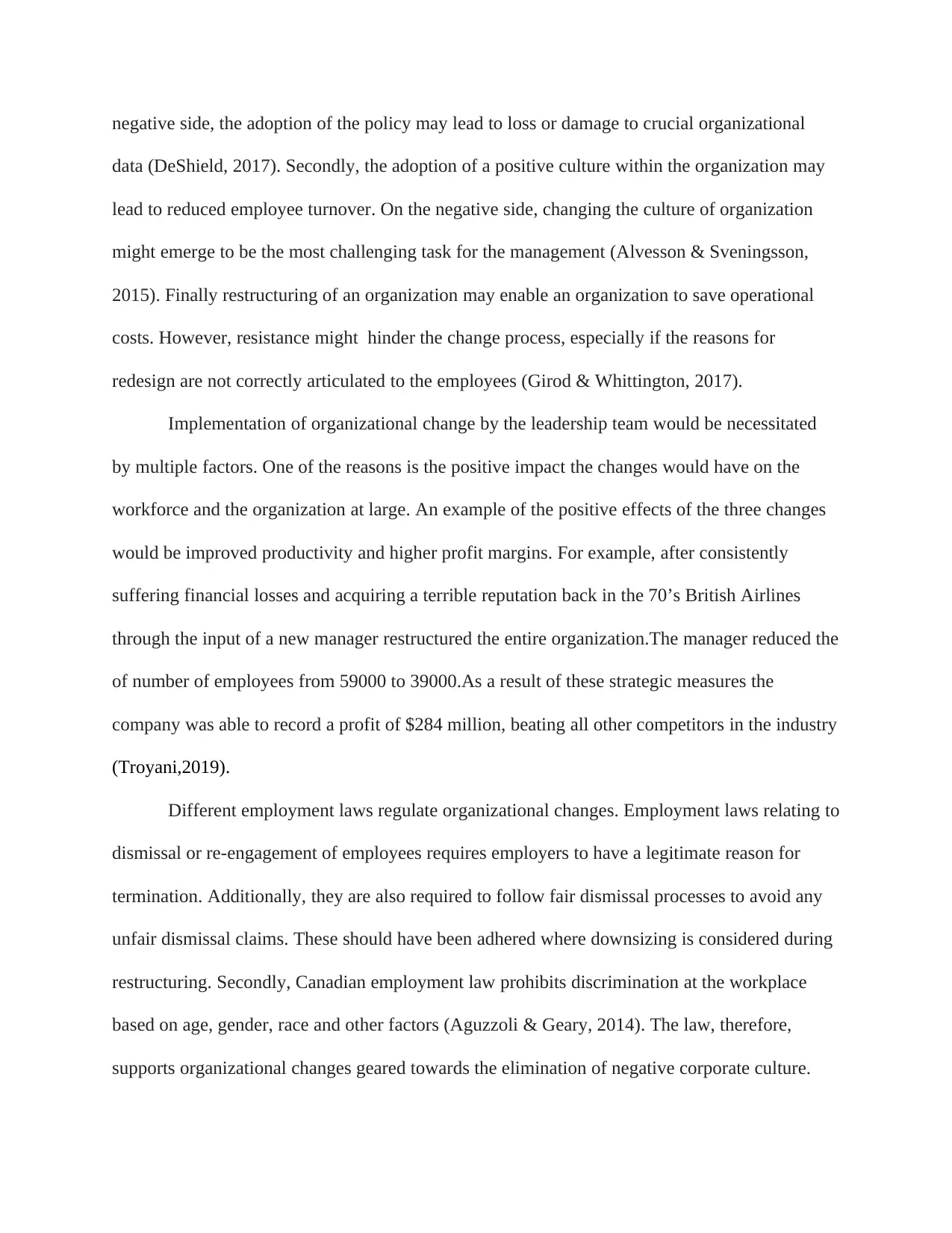
negative side, the adoption of the policy may lead to loss or damage to crucial organizational
data (DeShield, 2017). Secondly, the adoption of a positive culture within the organization may
lead to reduced employee turnover. On the negative side, changing the culture of organization
might emerge to be the most challenging task for the management (Alvesson & Sveningsson,
2015). Finally restructuring of an organization may enable an organization to save operational
costs. However, resistance might hinder the change process, especially if the reasons for
redesign are not correctly articulated to the employees (Girod & Whittington, 2017).
Implementation of organizational change by the leadership team would be necessitated
by multiple factors. One of the reasons is the positive impact the changes would have on the
workforce and the organization at large. An example of the positive effects of the three changes
would be improved productivity and higher profit margins. For example, after consistently
suffering financial losses and acquiring a terrible reputation back in the 70’s British Airlines
through the input of a new manager restructured the entire organization.The manager reduced the
of number of employees from 59000 to 39000.As a result of these strategic measures the
company was able to record a profit of $284 million, beating all other competitors in the industry
(Troyani,2019).
Different employment laws regulate organizational changes. Employment laws relating to
dismissal or re-engagement of employees requires employers to have a legitimate reason for
termination. Additionally, they are also required to follow fair dismissal processes to avoid any
unfair dismissal claims. These should have been adhered where downsizing is considered during
restructuring. Secondly, Canadian employment law prohibits discrimination at the workplace
based on age, gender, race and other factors (Aguzzoli & Geary, 2014). The law, therefore,
supports organizational changes geared towards the elimination of negative corporate culture.
data (DeShield, 2017). Secondly, the adoption of a positive culture within the organization may
lead to reduced employee turnover. On the negative side, changing the culture of organization
might emerge to be the most challenging task for the management (Alvesson & Sveningsson,
2015). Finally restructuring of an organization may enable an organization to save operational
costs. However, resistance might hinder the change process, especially if the reasons for
redesign are not correctly articulated to the employees (Girod & Whittington, 2017).
Implementation of organizational change by the leadership team would be necessitated
by multiple factors. One of the reasons is the positive impact the changes would have on the
workforce and the organization at large. An example of the positive effects of the three changes
would be improved productivity and higher profit margins. For example, after consistently
suffering financial losses and acquiring a terrible reputation back in the 70’s British Airlines
through the input of a new manager restructured the entire organization.The manager reduced the
of number of employees from 59000 to 39000.As a result of these strategic measures the
company was able to record a profit of $284 million, beating all other competitors in the industry
(Troyani,2019).
Different employment laws regulate organizational changes. Employment laws relating to
dismissal or re-engagement of employees requires employers to have a legitimate reason for
termination. Additionally, they are also required to follow fair dismissal processes to avoid any
unfair dismissal claims. These should have been adhered where downsizing is considered during
restructuring. Secondly, Canadian employment law prohibits discrimination at the workplace
based on age, gender, race and other factors (Aguzzoli & Geary, 2014). The law, therefore,
supports organizational changes geared towards the elimination of negative corporate culture.
⊘ This is a preview!⊘
Do you want full access?
Subscribe today to unlock all pages.

Trusted by 1+ million students worldwide
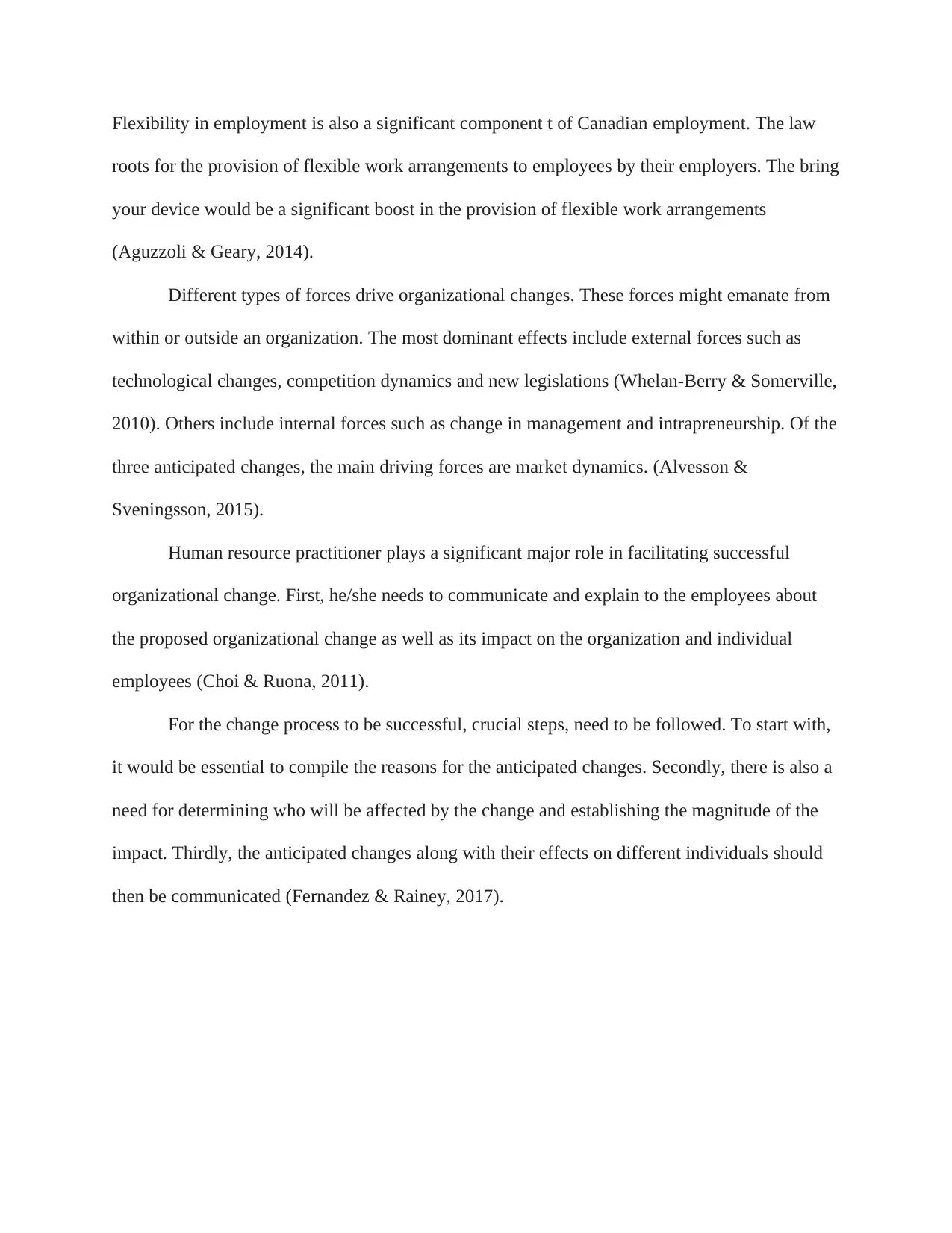
Flexibility in employment is also a significant component t of Canadian employment. The law
roots for the provision of flexible work arrangements to employees by their employers. The bring
your device would be a significant boost in the provision of flexible work arrangements
(Aguzzoli & Geary, 2014).
Different types of forces drive organizational changes. These forces might emanate from
within or outside an organization. The most dominant effects include external forces such as
technological changes, competition dynamics and new legislations (Whelan-Berry & Somerville,
2010). Others include internal forces such as change in management and intrapreneurship. Of the
three anticipated changes, the main driving forces are market dynamics. (Alvesson &
Sveningsson, 2015).
Human resource practitioner plays a significant major role in facilitating successful
organizational change. First, he/she needs to communicate and explain to the employees about
the proposed organizational change as well as its impact on the organization and individual
employees (Choi & Ruona, 2011).
For the change process to be successful, crucial steps, need to be followed. To start with,
it would be essential to compile the reasons for the anticipated changes. Secondly, there is also a
need for determining who will be affected by the change and establishing the magnitude of the
impact. Thirdly, the anticipated changes along with their effects on different individuals should
then be communicated (Fernandez & Rainey, 2017).
roots for the provision of flexible work arrangements to employees by their employers. The bring
your device would be a significant boost in the provision of flexible work arrangements
(Aguzzoli & Geary, 2014).
Different types of forces drive organizational changes. These forces might emanate from
within or outside an organization. The most dominant effects include external forces such as
technological changes, competition dynamics and new legislations (Whelan-Berry & Somerville,
2010). Others include internal forces such as change in management and intrapreneurship. Of the
three anticipated changes, the main driving forces are market dynamics. (Alvesson &
Sveningsson, 2015).
Human resource practitioner plays a significant major role in facilitating successful
organizational change. First, he/she needs to communicate and explain to the employees about
the proposed organizational change as well as its impact on the organization and individual
employees (Choi & Ruona, 2011).
For the change process to be successful, crucial steps, need to be followed. To start with,
it would be essential to compile the reasons for the anticipated changes. Secondly, there is also a
need for determining who will be affected by the change and establishing the magnitude of the
impact. Thirdly, the anticipated changes along with their effects on different individuals should
then be communicated (Fernandez & Rainey, 2017).
Paraphrase This Document
Need a fresh take? Get an instant paraphrase of this document with our AI Paraphraser
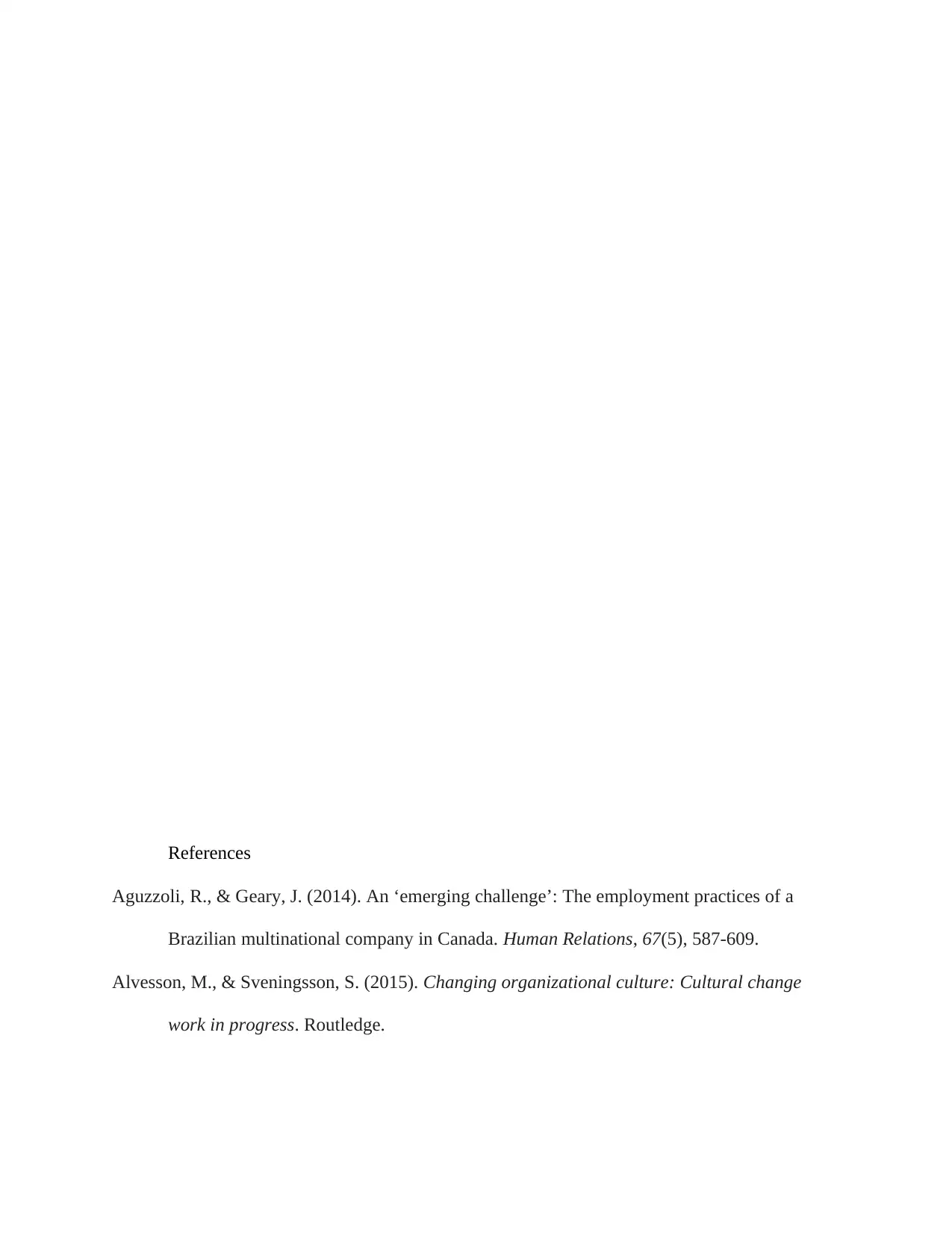
References
Aguzzoli, R., & Geary, J. (2014). An ‘emerging challenge’: The employment practices of a
Brazilian multinational company in Canada. Human Relations, 67(5), 587-609.
Alvesson, M., & Sveningsson, S. (2015). Changing organizational culture: Cultural change
work in progress. Routledge.
Aguzzoli, R., & Geary, J. (2014). An ‘emerging challenge’: The employment practices of a
Brazilian multinational company in Canada. Human Relations, 67(5), 587-609.
Alvesson, M., & Sveningsson, S. (2015). Changing organizational culture: Cultural change
work in progress. Routledge.
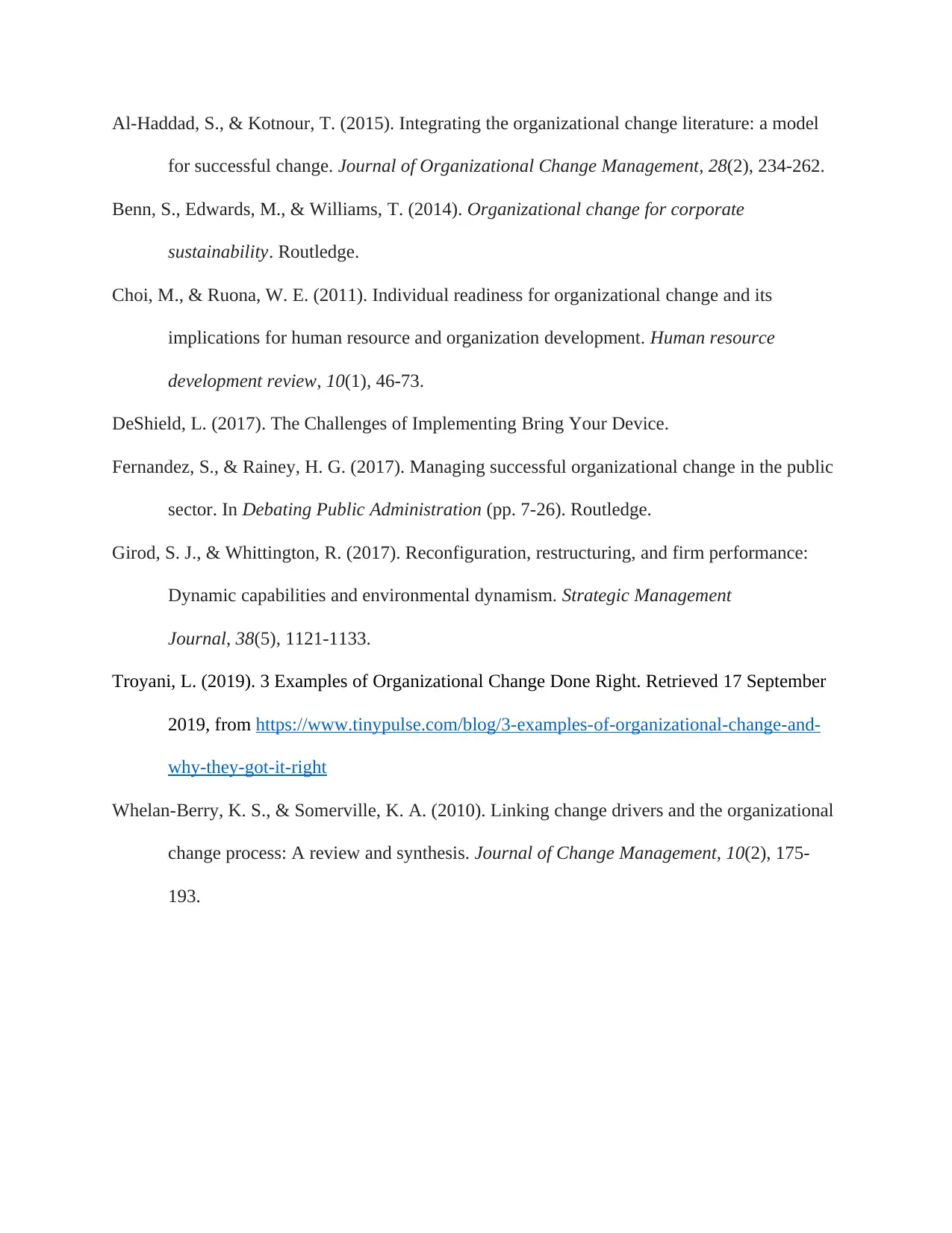
Al-Haddad, S., & Kotnour, T. (2015). Integrating the organizational change literature: a model
for successful change. Journal of Organizational Change Management, 28(2), 234-262.
Benn, S., Edwards, M., & Williams, T. (2014). Organizational change for corporate
sustainability. Routledge.
Choi, M., & Ruona, W. E. (2011). Individual readiness for organizational change and its
implications for human resource and organization development. Human resource
development review, 10(1), 46-73.
DeShield, L. (2017). The Challenges of Implementing Bring Your Device.
Fernandez, S., & Rainey, H. G. (2017). Managing successful organizational change in the public
sector. In Debating Public Administration (pp. 7-26). Routledge.
Girod, S. J., & Whittington, R. (2017). Reconfiguration, restructuring, and firm performance:
Dynamic capabilities and environmental dynamism. Strategic Management
Journal, 38(5), 1121-1133.
Troyani, L. (2019). 3 Examples of Organizational Change Done Right. Retrieved 17 September
2019, from https://www.tinypulse.com/blog/3-examples-of-organizational-change-and-
why-they-got-it-right
Whelan-Berry, K. S., & Somerville, K. A. (2010). Linking change drivers and the organizational
change process: A review and synthesis. Journal of Change Management, 10(2), 175-
193.
for successful change. Journal of Organizational Change Management, 28(2), 234-262.
Benn, S., Edwards, M., & Williams, T. (2014). Organizational change for corporate
sustainability. Routledge.
Choi, M., & Ruona, W. E. (2011). Individual readiness for organizational change and its
implications for human resource and organization development. Human resource
development review, 10(1), 46-73.
DeShield, L. (2017). The Challenges of Implementing Bring Your Device.
Fernandez, S., & Rainey, H. G. (2017). Managing successful organizational change in the public
sector. In Debating Public Administration (pp. 7-26). Routledge.
Girod, S. J., & Whittington, R. (2017). Reconfiguration, restructuring, and firm performance:
Dynamic capabilities and environmental dynamism. Strategic Management
Journal, 38(5), 1121-1133.
Troyani, L. (2019). 3 Examples of Organizational Change Done Right. Retrieved 17 September
2019, from https://www.tinypulse.com/blog/3-examples-of-organizational-change-and-
why-they-got-it-right
Whelan-Berry, K. S., & Somerville, K. A. (2010). Linking change drivers and the organizational
change process: A review and synthesis. Journal of Change Management, 10(2), 175-
193.
⊘ This is a preview!⊘
Do you want full access?
Subscribe today to unlock all pages.

Trusted by 1+ million students worldwide
1 out of 6
Related Documents
Your All-in-One AI-Powered Toolkit for Academic Success.
+13062052269
info@desklib.com
Available 24*7 on WhatsApp / Email
![[object Object]](/_next/static/media/star-bottom.7253800d.svg)
Unlock your academic potential
Copyright © 2020–2025 A2Z Services. All Rights Reserved. Developed and managed by ZUCOL.




